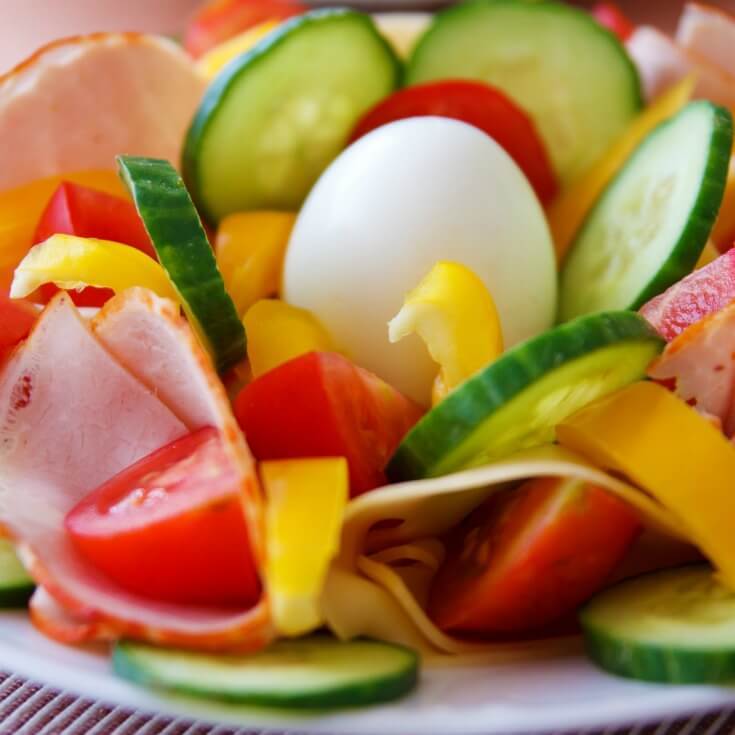Why do low carb diets work so well? And, do low carb diets work long term? Here’s the basics you need to know on how a low carb diet works.

Are low-carb diets a health fad? Why do low carb diets work so well? Is sticking to a low-carb diet something you should really consider? In a couple years, will low-carb diets be a dietary afterthought? Will they be ridiculed like other popular diets like the Master Cleanse? (Remember that fad? You drink nothing but pure water with lemon juice, cayenne pepper and maple syrup for several days.)
Low carb diets are not a health fad. In fact, for the first nearly 200,000 years that modern homo sapiens have existed, low-carb diets have been all the rage. It’s only been in the last couple hundred years or so that low-carb diets would be considered out of the ordinary. That’s because the industrial revolution eventually figured out how to make massive amounts of starchy carbohydrates. These high-carb foods include rice, pasta, potatoes and bread.
Prior to mass-produced high-carb foods, human beings subsisted as hunter-gatherers. Hunter-gatherers ate mostly wild game, seasonal berries, seeds, nuts and wild grasses and shoots and herbs. The only carbs pre-agricultural revolution humans ate were fruits and some vegetables. An extremely thorough analysis of pre-agricultural diets in Scientific American claims that most of these vegetables were “fungus-covered tropical leaves.” (Yuck!)
Even if most of the veggies consumed by pre-modern agricultural societies were asparagus and spinach, the diet was low in carbs. In fact, human beings have subsisted on low carb diets for almost the entire history of mankind.
It’s only been in the recent blink of an evolutionary eye that foods high in carbohydrates have been consumed. And it’s been a fraction of that same blink that these high-carb foods have been consumed on a mass scale by a majority of the world’s population.
Health Risks of High-Carb Diets
It’s no wonder that the rates of obesity, diabetes, other metabolic disorders and chronic illnesses have skyrocketed in recent years. Both the mass-consumption of high-starch carbohydrates and the federal government’s suggestion to eat a low-fat diet, started in the middle of the 20th century. This has caused health issues to rise.
Well over 30 million people have diabetes in the United States, according to government statistics. Almost 36 percent of U.S. adults are obese. More than six percent are considered extremely obese. These sobering stats implicate high-carb diets as well as other poor lifestyle choices, such as lack of exercise and smoking. Cancer, high-blood pressure, stroke, and other illnesses are also attributable, at least in part, by high-carb consumption.
The problem with high-carb foods is that they raise blood sugar levels and make the body more resistant to insulin. Insulin is the hormone that escorts sugar into the cells from the bloodstream. However, eating too many high-starch foods (starches are quick-burning carbohydrates) causes insulin to interfere with fat burning; excess insulin causes the liver to store unburned blood sugar as body fat.
Why do low carb diets work so well? In simple terms, significantly reducing carb intake can stop the endless cycle of insulin production that leads to excess fat storage. This turns the body into a fat burning machine rather than a fat storing machine.

How to Get Started on a Low Carb Diet: Replacing High-Carb Foods
Now that we have a basic answer for the question “Why do low carb diets work?” you may wonder how to replace the high carb food you’ve been eating. Many people considering going on a low carb diet don’t know where to begin. The first step is to take one meal per day and ditch a high-carb food. There are many lower carb versions of high-carb foods that taste just as good but won’t spike your blood sugar.
Let’s start with breakfast. Instead of eating two slices of white or wheat toast (even 100% whole wheat), you can eat an almond-flour or coconut-flour bread substitute instead. Healthier, low-starch breads, can be expensive though.
If the cost of these breads is prohibitive, ditch the bread altogether and increase the amount of fat, protein and fiber in your breakfast. For example, if you’re used to eating one egg, eat two eggs. Eggs have both healthy fats (if you eat the yolk) and protein.
For snacks, you can eat a celery stalk with almond butter or natural unsweetened peanut butter for added healthy fats. You can also make a healthy smoothie with almond milk, a nut butter of your choice, flax seeds, spinach and a small amount of zero-sugar all-natural sweetener, such as stevia or monk fruit extract.
Lunch and dinner are the trickier meals to ditch the high-carb foods. That’s because many people usually have pasta, rice, and potatoes for lunch or dinner. Or both. Having a lean piece of protein and lots of veggies and a salad for lunch and dinner usually does the trick. The fiber from the roasted, steamed, or sauteed veggies, and from the salad will help fill you up. Try to eat the salad like Mediterranean people do: after the main meal. Eat a handful of walnuts and blueberries for dessert, and a small piece of extreme dark chocolate for dessert. You will likely feel pleasantly stuffed and won’t miss having any high-starches.
How to Get Started on a Low Carb Diet: High-Carb Withdrawal
For some people, quitting high-starch carbs cold turkey can lead to a mild flu-like carb withdrawal. This is known as keto flu. To combat feeling sick, drinking homemade bone broth usually does the trick.
If you notice that you’re craving carbs, simply reduce the serving size you usually eat for a week or two. From there, keep gradually reducing the amount of high-starch carbs while increasing your protein, natural fat, and fiber intake. But, be aware that eating carbs induces carb cravings. This is particularly true with sweets. Sweets tend to make people hungrier and crave carbs. Therefore, another reason why low carb diets work so well is because they reduce hunger.

How to Get Started on a Low Carb Diet: Using Technology to Stay Low Carb
Calorie smartphone apps like MyFitnessPal can help you stick to a low-carb diet. And, you can use a keto calculator to determine the macros you should aim for. The amount of grams of carbohydrates in a true low-carb diet usually does not exceed 150 per day. The low-end of low-carb diet carb intake is 50 grams of carbs per day. If you’re new to a low-carb diet, do not try to consume the low-end of the daily carb intake. Start with a higher carb intake and gradually reduce, if you’re able to.
You may be wondering where you’ll get all your energy from if you don’t eat pasta, rice and bread. But first ask yourself how you feel after you usually eat those foods. Many times, you probably feel very sluggish. That’s because high-starch foods quickly raise your blood sugar. And what skyrockets up must eventually plunge. When you eat a low-carb diet correctly, that is, eating enough fiber, healthy fats and lean protein, you’ll find you’ll have more steady energy throughout the day. If you really need it, your brain can use some of your stored bodyfat for energy.
Why do Low Carb Diets Work Long Term?
For approximately 200,000 years, human beings did not require pasta and other high-starch carbs for energy. So don’t think you need high-starch carbs either. And don’t worry about whether or not you’re getting enough carbs while on a low-carb diet. If you’re eating plenty of vegetables and some fruit, those are really all the carbs you need. When you ditch unhealthy carbs, another bonus is that you’ll be pleasantly surprised at how fresh fruit tastes so naturally sweet!
Why Do Low Carb Diets Work So Well – Conclusion
Keeping your blood sugar levels where they were intended to be is the main reason why low carb diets work so well. Beyond that, reducing carbs in your diet and increasing fat curbs hunger and keep you full longer. For more ideas on how to get started on a low carb diet, read this post.
We really shouldn’t be asking “Why do low carb diets work so well?” The real question is “Why are people continuing to eat an unhealthy diet high in carbohydrates?”
Thinking about starting a low carb diet? You can start by making low carb keto dinner recipes.
You may also be interested in knowing that a low carb meal plan can be part of a canine holistic cancer treatment. And if you need more, check out these other resources:
21 Soul-filling Low Carb Recipes
Low Carb Yellow Summer Squash Recipes
Low Carb Diet Cheat Day or Meals – Is It OK?
Low Carb vs Low Fat Diets: What’s Better?






